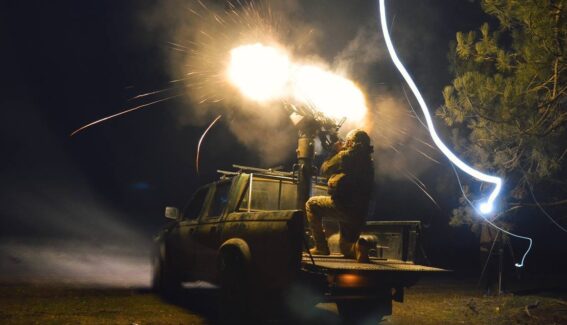Putin Has Already Lost in Ukraine—The Extent of That Loss Depends on What the West Does Next

Trump to the Rescue?
On July 15, President Donald Trump announced that the U.S. would be sending more weapons to Ukraine, primarily the air defense Patriot missile systems, via purchases from NATO allies. He then gave Moscow 50 days to agree to a peace deal to end its invasion of Ukraine, or else face 100 percent secondary tariffs on countries that buy Russian products, primarily its oil. This could slow the funding of Putin’s war machine for a time, but would it be enough to get the Kremlin to seriously negotiate a long-term ceasefire that would end years of carnage?
Putin has already lost the war in Ukraine. Even as his depleted military slowly inches westward in its unimpressive summer offensive, the casualty rate of Russian troops has reached the staggering one million mark in just over three years. It is estimated that one-fourth of these casualties are battle deaths. In June, his air power was seriously depleted, losing over 40 high value planes, by a surprise and ingenious drone attack by the Security Service of Ukraine (SBU), dubbed Operation Spider’s Web. Much of his Black Sea Fleet has had to depart Crimea due to the ability of Ukraine’s special operations forces (SSO) to strike his naval vessels with surface or underwater drones. The list goes on, but the once feared Russian military machine has proven to be overhyped and overrated. Failed reform attempts, corruption, and the nature of Putin’s authoritarian state have returned limited gains compared to massive losses and a stalemated war with a much smaller and less powerful neighbor.
Putin’s use of realpolitik-style power politics over the past two decades have not worked. His long-term strategic goals are further from his grasp than ever before. Most importantly, he has galvanized Ukrainian nationhood, and a once divided nation stands as one against his naked aggression. His dreams of a restored Russian empire where Ukraine and other former Soviet states are permanently brought back into Moscow’s orbit have vanished due to his 2022 miscalculations. He has lost his cash cow: natural gas and oil revenue from the lucrative European market, perhaps permanently. His actions in Ukraine have led to NATO expansion, not contraction, and Russia’s border with the alliance has doubled with Finland’s entry. Putin has exposed Russia as a paper tiger, a hollowed out former superpower being embarrassed on the battlefield by a smaller but smarter Ukrainian fighting force.
Putin Cannot Win
In our forthcoming book, Modern Hybrid Warfare: Russia versus the West, we utilize data analyses and in-depth qualitative methods to show Putin’s failures in Ukraine by dissecting the different facets of the hybrid operations in the full-scale war in Ukraine (2022- present). Our primary argument is that emerging technology does not change the nature of warfare; in fact, it can make it bloodier. With the help of allies and its own homegrown ingenuity, Ukraine has reached technological parity with its larger opponent, and this has led to a stalemate in the trenches of Eastern and Southern Ukraine, where every inch gained is paid for with gallons of blood.
The use of cheap and stealthy drones, for air, sea, and underwater, have allowed the Ukrainians to fight smarter. First-person view (FPV) drones have been essential for intelligence collection and influence operations. Unmanned surface and underwater vehicles (USV, UUV) have allowed a navy-less Ukraine to drive the Black Sea Fleet out of Crimea. Western electronic warfare (EW) equipment and Ukrainian ingenuity has balanced this capability against the Russians who had a clear advantage before the war. The use of private sector space technology has also given the Ukrainians parity with a country with numerous assets in orbit.
Cyber operations have also been relegated to secondary status as a result of Ukrainian preparedness and ingenuity, and well as support from Western military cyber commands and the private sector. A good defense has been able to counter an offensive-minded Russian cyber power, and we have observed a relative balance between the two sides in the digital space.
Artificial intelligence, specifically LLMs, has enhanced the scope and scale of influence operations for both Ukraine and Russia. Ukraine has been successful with creating narratives that evoke anger or humor, and are visual, attributes that social psychology has proven to be the most successful in terms of memory retention. Memetic warfare is real and a very important part of Ukraine’s continued support from its public as well as its international partners. Russia’s influence operations, although successful with its domestic audience, have fallen flat with most international audiences. The overuse of the Nazi trope where Russia accuses Ukraine’s government of being run by the far-right, the continued bombastic nuclear saber-rattling, and framing the West as the aggressor in this conflict have fallen flat for the most part, and support for Ukraine remains high.
Both Russia and Ukraine’s militaries have evolved from their Soviet legacies. These legacies include rampant corruption, poorly trained and equipped soldiers, a focus on mass tactics with a glut in officer corps, and inferior military equipment when compared with Western counterparts. After the suboptimal performance of the Russian military operation in Georgia in 2008, Putin directed that the military be reformed. However, the continuing legacy of corruption, poor leadership and training, and low morale among the enlisted continued, and the result has been a disaster for Putin’s Ukraine blunder.
Ukraine, on the other hand, after the 2014 illegal Crimean annexation and conflict in the Donbas, realized that it must modernize its military to prepare for a Russian invasion, and fast. Over the next eight years, Ukraine reformed its military to reflect those of the West, as U.S. and NATO allies helped train, equip, and reorganize a military in tatters. The results of these reforms have been seen on the battlefield: non-commissioned officers making autonomous battlefield decisions, better training and morale among troops, and superior equipment and tactical groups have kept Ukraine in the fight against its much larger invader.
Increased Western Support Can End the War, On Ukraine’s Terms
Although Trump’s U-turn on arming Ukraine is of great relief to Kyiv, the U.S. and its NATO allies must do more to put Putin in such a corner that he must sue for peace on Kyiv’s terms or else see his regime collapse. As Putin has shown little concern for the human and economic toll of the war on Russia, his acknowledgment of his military’s culmination, its inability to continue effective operations, will require the West to bolster Ukraine’s military so that it can break the stalemate and be capable of a counteroffensive.
One million battle casualties, an estimated 250,000 dead, a collapsing economy, and international pariah status is what Putin has achieved in his full-scale invasion of Ukraine. He has needed Iranian drones, North Korean soldiers, Indian labor, and Chinese technology to keep his stagnated war machine afloat. Russian birthrates are so dismal he has had to enact a policy of incentivizing Russian women to have more children. Many of Russia’s best minds have fled the country to avoid conscription. Whatever the eventual outcome of this war brings, Putin has already lost the war in Ukraine.
However, Ukraine is also running out of time. War fatigue, decreased US support for the weapons needed for battlefield advantage, and the decreasing supply of capable men and women for the frontlines have prevented Ukrainian forces from being capable of launching offensive operations to drive the Russians from Ukrainian territory. If President Trump wants an end to this war as quickly as possible as he has stated, a full-court press on Russia’s war machine is needed. Coordination with NATO as well as global allies and partners is key.
Diplomatically, the U.S. and NATO must make clear to the primary enablers of Russia’s war machine, China, North Korea, Iran, and North Korea, that the cost of doing business with Putin will not be worth it. Economically, biting sanctions not only on Russia’s economy but also those buying Russian oil must be followed through by Trump. Militarily, the U.S. and NATO must provide Ukraine with everything on its wish list as quickly as possible. Kyiv’s military must be able to go on the offensive, and full Western support is a must. If Trump wishes to focus on China and deter its more aggressive international moves, he must help Putin lose as much as possible in Ukraine.





